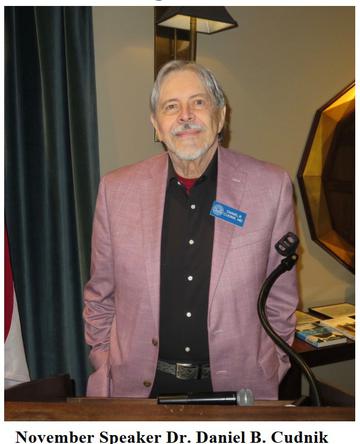November 2022 Meeting

At our dinner meeting on November 16th, Round Table member, Dr. Daniel B. Cudnik gave a very interesting program titled: “A Forensic Study of the Lincoln Assassination.” Dr. Cudnik viewed Lincoln's assassination through a medical lens. He discussed what happened before the crime, what happened during the crime, and what happened after the crime.
Dr. Cunik's presentation began with Lee's surrender on April 9, 1865 and covered the events leading to the murder of the President. Following the fatal shot by John Wilkes Booth on April 14th, Lincoln was taken to Dr. Peterson's house across the street from Ford's Theatre. There, President Lincoln was given what was then considered cutting-edge medical treatment. A young surgeon, Dr. Charles A. Leale, who was familiar with wounds and wound care, rendered the following aid:
- Checked Lincoln's vital signs.
- Cleared Lincoln's airway and gave him mouth-to-mouth resuscitation.
- Gave Lincoln artificial respiration by lifting Lincoln's arms.
- Further examined Lincoln.
- Performed digital probe of Lincoln's head wound. Episodic probing improved Lincoln's blood pressure and pulse, which prolonged Lincoln's life.
Treatment of gunshot wounds in 1865 was vastly different than it is today:
- Louis Pasteur and Robert Koch discovered that certain germs cause certain diseases in 1872-1882.
- X-rays were discovered in 1895.
- Blood groups were discovered in 1901, which then allowed blood transfusions.
- Penicillin was discovered in 1928. No antibiotics were available in 1865.
- Sulfa, an antibacterial drug, was discovered in 1932.
President Lincoln succumbed to his head wound on the morning of April 15 th and was transported to the White House for an autopsy, which was performed by two pathologists: Dr. J. Janvier Woodward and Dr. Edward Curtis. Dr. Cudnik discussed the autopsy findings in great detail. The 0.44 caliber bullet went through the left side of Lincoln's skull and caused a great deal of bone and brain injury. Based on the region of the brain that was damaged, Lincoln probably would have been blind and had loss of sensation and loss of motor functions if he had lived.
The aftermath of the assassination was also discussed. John Wilkes Booth fled to Garrett's Farm on April 24th and hid in a tobacco bam. The Union troops wanted to capture Booth. However, Boston Corbet, one of the Union soldiers, shot Booth in order to keep him from shooting at the Union troops. The bullet went through Booth's neck bones and severed his spinal chord. Booth died on the morning of April 25th.
Dr. Cudnik also discussed Major Henry Rathbone’s tragic life and Boston Corbet’s descent into insanity. Major Rathbone and Clara Harris, who were engaged to be married, were sitting with President and Mrs. Lincoln when the President was shot. Booth stabbed Rathbone in the arm in order to escape. Rathbone became very depressed over Lincoln's assassination and thought maybe he could have prevented it. Rathbone killed his wife in 1883. He was declared insane and died in 1911.